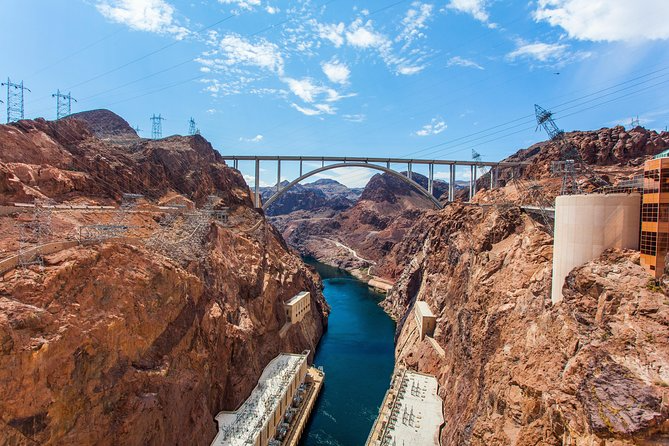See more of the Hoover Dam than any other tour from Las Vegas
What’s included?
- Professional stand-up comedian tour guide.
- Hoover Dam Powerplant tour
- (Adventure down into the inside of the dam to view the powerplant room)
- exclusive, fully guided “Walk on the Top” tour of the dam.
- Lunch
- Hotel pickup and drop-off in a VIP luxury bus with
- Bathroom on-board
- Designated Bus Driver
- Bottled water Stops at the
- Welcome to Las Vegas Sign. The best place in Vegas for a photo.
- Complimentary ticket for the LA Comedy Club at the Strat.
The Hoover Dam (originally known as Boulder Dam) is an inspiring symbol of American engineering, built during America’s Great Depression as the then-largest dam construction project in the world. Travelers have flocked here for decades to see picturesque views of Lake Mead and the Colorado River, and today, the dam receives more than 1 million annual visitors.
Hoover dam tour itinerary
tart your tour with pickup from select Las Vegas hotels and we don’t take you to a central location to reload onto a different bus. You will go out on the bus you were picked up in. Limiting pick-ups and traveling on one bus allows us to save time and get back early. It can take hours to pull in and out of every hotel. By limiting pick-ups to 7 we are usually the first bus company to Hoover Dam. En route, your comedian tour-guide entertains and answers questions Hoover Dam, its history and/or the Las Vegas area.
All of our fully air-conditioned buses have panoramic windows for optimal viewing opportunities, and bathrooms on board.
Welcome to Fabulous Las Vegas Sign We include a photo stop at the famous Welcome to Las Vegas Sign – Our guides will show you the best place to stand to get your photos to create a happy memory of your time in Vegas. 15 minutes
Hoover Dam Bypass Our buses have an added treat, a photo stop at the new Hoover Dam bypass bridge for the single best view available of Hoover Dam. Get those cameras ready for the best selfie ever! 1 hour •
Boulder Travel through historic Boulder City, viewing the quaint Dingbat houses which were built for the Dam Workers, and the historic Hoover Dam Hotel. 1 hour • Admission Ticket Free 5
Hoover Dam On arrival, you’ll begin with a generator viewing. Travel 524 feet (160 meters) into the walls of Black Canyon to view the Nevada power-plant, generators and a 30-foot-diameter (9-meter) pipe inside one of the four giant diversion tunnels. Next, head into the Hoover Dam Visitor Center where you can see the history of Hoover Dam and view numerous exhibits that explain how the dam was built, how it operates and who benefits from the water and electricity. Walk on the Top Tour – This is an exclusive, fully guided comprehensive 45-minute walk over the top of the dam. Your knowledgeable guide will touch all aspects of the dam including electricity, outlet works, intake towers, concrete, diversion tunnels, water/drought, deaths, wages, earthquakes, artwork, WWII and more.
Henderson
The Hoover Dam
The Hoover Dam, 1941.
Eighty-five years after its completion, Hoover dam is still considered an engineering marvel. It is named in honor of President Herbert Hoover, — who played a crucial role in its creation.
For many years, residents of the American southwest sought to tame the Colorado to prevent flooding and provide irrigation to transform the arid region into fertile cropland. The greatest obstacle to constructing a dam was the issue of water rights allocation among the seven states of the Colorado River drainage basin. It became evident after meetings held at San Diego, Tucson, Salt Lake City, Los Angeles, and Denver that a formal agreement for the equitable apportionment of the water between the states was needed.
Herbert Hoover had visited the Lower Colorado region in the years before World War and was familiar with its problems and the potential for development. Upon becoming Secretary of Commerce in 1921, Hoover proposed the construction of a dam on the Colorado River. In addition to flood control and irrigation, it would provide a dependable supply of water for Los Angeles and Southern California. It would recover its cost through the sale of the hydroelectric power it generated.
The Colorado River Commission when they signed the Colorado River Compact in Santa Fe, NM on November 24, 1922.
In 1921, the state legislatures of the Colorado River basin authorized commissioners to negotiate an interstate agreement. Congress authorized President Harding to appoint a representative for the federal government to serve as chair of the Colorado River Commission and on December 17, 1921, Harding appointed Hoover to that role.
When the commission assembled in Santa Fe in November 1922, the seven states still disagreed over the fair distribution of water. The upstream states feared that the downstream states would be allocated the vast majority of the water due to their rapidly developing agricultural and power needs. Hoover suggested a compromise that the water be divided without individual state quotas. The resulting Colorado River Compact was signed on November 24, 1922. It split the river basin into upper and lower halves with the states within each region deciding amongst themselves how the water would be allocated.
Bills calling for Federal funding to build the dam were introduced by Congressman Phil D. Swing and Senator Hiram W. Johnson between 1922 and 1928, all of which were rejected. The final Swing-Johnson bill, titled the Boulder Canyon Project Act, was largely written by Hoover and Secretary of the Interior Hubert Work. The bill passed on December 18, 1928 and President Herbert Hoover signed a proclamation on June 25, 1929 making the Compact effective.
Appropriations were approved and construction began in 1930. The dam was dedicated in 1935 and the hydroelectric generators went online in 1937. In 1947, Congress officially “restored” Hoover’s name to the dam, after FDR’s Secretary of the Interior tried to remove it. Hoover Dam was built for a cost of $49 million (approximately $760 million adjusted for inflation). The power plant and generators cost an additional $71 million. The sale of electrical power generated by the dam paid back its construction cost, with interest, by 1987.
Today the Hoover Dam controls the flooding of the Colorado River, irrigates to over 1,500,000 acres of land, and provides water to over 16,000,000 people. Lake Mead supports recreational activities and provides habitats to fish and wildlife. Power generated by the dam provides energy to power over 500,000 homes. The Hoover Compromise still governs how the water is shared.
cc



